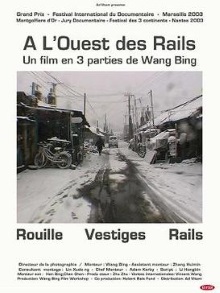
This came to my attention when I read about critics including it as one of the most important films of the 21st century so far. I also found the premise of a long documentary about post-industrial decline in China very interesting. Tracking down a watchable copy was a real chore however and that’s not surprising as not many people would likely want to watch a documentary film with a total running time that exceeds nine hours. My wife and I spread out the experience over many days, treating it essentially as if we were watching a television series.
The subject at hand is the large industrial zone of Shenyang city called the Tiexi district. The first episode covers several of the government-owned factories. Saddled by debt and owing the workers many months of wages, the writing is clearly on wall for them. The workers constantly grip about their low pay and wonder when the factories will shut down for good. Eventually they even openly discuss stealing parts from the factory in order to sell them as scrap later. The second episode deals with the local residents and how they get by. As the factories close, they are ordered to leave their homes in exchange for flats elsewhere so that the land can be redeveloped. The last episode talks about the rail network that services the factories and follows a train crew around. It eventually focuses on the story of man who goes all over the rails collecting scrap to sell but also apparently steals coal from the factories.
So obviously there is a lot of footage here but there is no narration at all. The only information provided is an explanatory blurb at the beginning of each episode and occasionally a note indicating when the scene was shot. Instead you need to work out what’s happening from the conversations between the various people that appear. As such this is less a properly organized documentary meant to inform you about its subject than a last minute attempt to capture on film the final months of this community. There’s a lot of tedium in here. For example, many of the scenes consist of the workers shooting the shit with each other in their break rooms. But there’s no doubt that this is a valuable record of the period and it’s fascinating in a voyeuristic way as we watch the workers and ordinary residents go about their lives and daily routines.
Your patience is rewarded by such extraordinary scenes such as workers chipping ice from the floors of a factory after a pipe burst in it, or a young man trying to woo a girl he likes with flowers during their equivalent of Valentine’s Day. Normal, except that he buys them from another girl who was given them as a present. To us, it’s also shocking how casual the male factory workers are about nudity, as they leisurely amble about in the break room completely naked or walk to and fro in the corridors. Across all three episodes, scrap scavengers are a constant sight and everything, even an odd bit of metal wiring, has value. One scene involves small boys arguing with one such scavenger over how much they should be paid for the tin cans they have collected. Everyone complains about how little money they have and how tough life is. They seem resentful of the government as well, grousing that they act in the interests of the rich and the well connected.
Still this film could have been so much more interesting if only it had tried to be more informative. Wang Bing, the director, and presumably also the cameraman who followed the lives of all these people in the Tie Xi district almost never asks questions of the subjects, preferring to film them as they are. So we can tell that the young men have jobs from their clothes, but not what they do. We see the trains running on different tracks at night but we don’t know what they’re carrying. It is however rather cool that the people being filmed do realize that the director is doing it to record the end of an era and seem to encourage him. They will well aware that soon all the factories will shut down, the ramshackle houses will be torn down and redeveloped and the entire district will be unrecognizable.
All this was filmed some twenty years and as we all know, China has made incredible progress since then. Most of the people shown here were fearful for their futures back then, yet even if many of the individuals weren’t quite able to land on their feet, it seems hard to argue against the fact that tearing down those old. outdated and very dangerous factories was necessary and people’s lives overall improved as a result of modernization. This film then has value as a record of an artifact of the past but I don’t the district as it was will be missed by anybody.
One thought on “Tie Xi Qu: West of the Tracks (2003)”